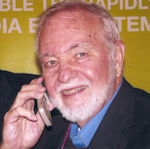Blazing-Fast Transceivers Swap Fiber For Copper In Short-Range Apps
Data centers typically use fiber-optic cabling to achieve fast data rates in applications that tie servers, routers, and other networking equipment together over short distances. Now, it's possible to interconnect these elements with lower-cost copper cables. With a new line of physical-layer (PHY) transceivers from Analogix Semiconductor, vendors can implement traditional standards-based links or proprietary links.
The IEEE 802.3ak standard, perhaps better known as 10GBaseCX4, implements four 3.125-Gbit/s links over 15 meters of InfiniBand cable. This can yield a gross transfer rate of 12.5 Gbits/s. A forthcoming IEEE standard, 802.3an 10GBaseT, potentially will offer 10 Gbits/s at longer distances via CAT6 or CAT7 unshielded twisted pair (UTP). It's years away from being finalized, so vendors are using the CX4 and in some cases a proprietary interface.
Analogix's solution is the D-PHY-5GC, the first transceiver chip to offer 6.25-Gbit/s serial data transfer on a copper twisted pair. It supports both UTP and InfiniBand cable. Using a proprietary approach, the chip can deliver an aggregate of 25 Gbits/s on InfiniBand cable up to 30 meters long. It also can achieve 12.5 Gbits/s on up to 5 meters of standard UTP. Such links are ideal for connecting stackable switches, cross-rack clusters, or other gear requiring short distances and very high speeds.
The D-PHY-5GC comes in two- and four-channel versions. The 2x5GC version has two 2- to 6.25-Gbit/s serial links and eight low-speed 500-Mbit/s links. It can produce up to 12.5-Gbit/s aggregate speed. The 4x5GC version has four similar high-speed links and the same eight low-speed links providing up to 25 Gbits/s on 15 to 35 meters of InfiniBand cable or 12.5 Gbits/s on 3 to 25 meters of UTP (see the figure).
TACKLING THE CHALLENGES The transceivers address the gnarly problems associated with trying to transmit high-speed binary data on a copper cable. These include major crosstalk between channel pairs, impedance discontinuities at cable/connector interfaces, and electromagnetic interference. A two-stage active linear equalizer on the receiver provides an appropriate high-frequency signal boost without introducing new noise effects or aggravating existing ones. The highly sensitive receiver can also recover signals from Analogix's very low-jitter transmitter, which uses minimal pre-emphasis and a low output swing to increase crosstalk immunity and deal with other noise issues.Other benefits of the 5GC include a strong bit error rate (BER) of 10-17, which far exceeds the 10-12 BER specified by the IEEE 10G standards. Also, designers can use smaller 28- or 30-gauge InfiniBand or UTP CAT 5e, 6, or 7 cables rather than the heavier 24-gauge cable typically specified by the InfiniBand standard. Finally, the 5GC consumes less than 3 W, while comparable products use about 10 W. This qualifies the chips for integration into copper-based versions of the standardized optical modules, such as XENPAK, X2, or XPAK.
The 5GC joins the company's previously announced D-PHY-2.5GC chip, which offers four channels of 2.5 Gbits/s and is designed for the CX4 standard interfaces. The encoding is binary, and the device supports the 802.3ak standard with InfiniBand cable providing 12.5 Gbits/s over 40 meters of distance.
Two additional chips are planned for the latter half of 2005, the D-PHY-10GC and 10GCE. The 10GC uses PAM 4 coding, while the 10GCE uses PAM 8/10 coding. The 10GCE will offer 10GBaseT-compatible performance of up to 12.5 Gbits/s over 70 to 100 meters or CAT6/7 UTP.
The D-PHY-5GC two-channel device costs $45, while the four-channel device goes for $75 in high volume. Samples are available now.
Analogix Semiconductor Inc.www.analogix.com